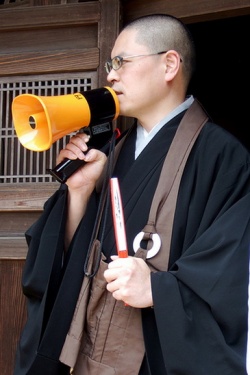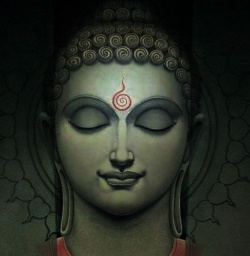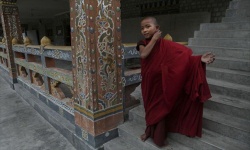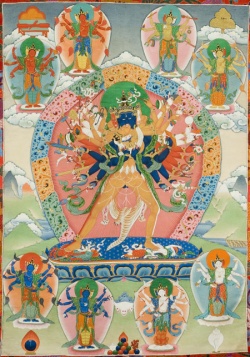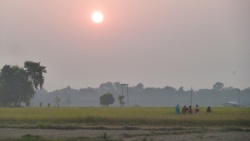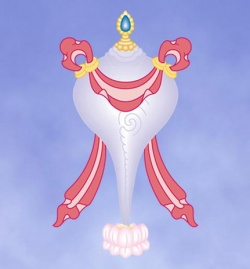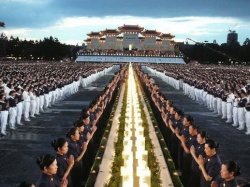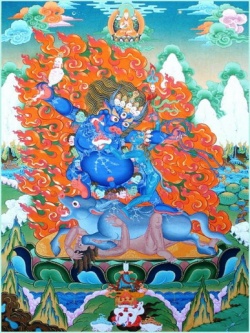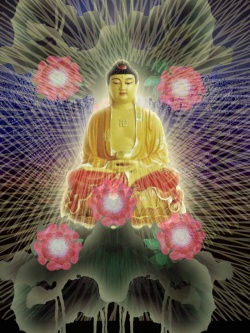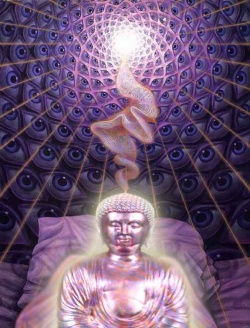Mahapadana Sutta
- The Mahapadana Sutta is the first sutta of the second division of the Digha Nikaya, called the Great Division.
Almost all of the suttas in the Great Division have “maha” (‘great’) in the title, although three do not, and there are suttas outside of the Great Division that have “maha” in the title (only one in the Digha Nikaya, but many more in the Majjhima, once again indicating the inconsistent organization of the Sutta Pitaka).
Although Walshe translates the sutta as the “Great Discourse on the Lineage,” a more literal translation might be, “The Sutta of the Great Transmission” [lit. ‘giving,’ ‘bestowing’].
In this sutta, the Buddha is at Savatthi, in the Kareri hutment, which is located in Anthapindika’s park in the Jeta Grove.
We encountered Savatthi in the Potthapada Sutta (9), where the Buddha discusses the higher extinction of consciousness with Potthapada.
A number of monks gather in the late morning at the Kareri pavilion, after the daily meal, and are discussing past lives.
Whereupon the Buddha joins them and asks them what they are talking about, so they tell him.
The Buddha proceeds to give the monastics a dharma talk on past lives. The Buddha names eight Buddhas who have appeared in the world hitherto, shown in the following table:
| Buddha | Time Ago | Caste | Clan | Lifespan (years) |
|---|---|---|---|---|
| Vipassi: | 91 eons | Khattiya | Kondanna | 80,000 |
| Sikhi: | 31 eons | Khattiya | Kondanna | 70,000 |
| Vessabhu: | 31 eons: | (same as Sikhi) | Khattiya Kondanna | 60,000 |
| Kakusandha: | Current eon | Brahman | Kassapa | 40,000 |
| Konmagamana: | Current eon | Brahman | Kassapa | 30,000 |
| Kassapa: | Current eon | Brahman | Kassapa | 20,000 |
| Gotama: | Current eon | Khattiya | Gotama | 100 |
Interestingly, the inclusion of Gotama creates a slight predominance of Khattiya over Brahman Buddhas, at least out of the most recent seven (there are of course many more). The lifespan of human beings at the time of Gotama is described as “short, limited, and quick.”
This lack of longevity may have something to do with the nature of the Buddha Gotama’s teaching, which (he says) is far more limited and narrowly focused than the whole teaching.
The text goes on to describe the different trees under which all of the different Buddha’s attained enlightenment; the names of each Buddha’s two noble disciples; the size of each one’s sangha of arhants; the name of each one’s personal attendant; the name of each one’s mother and father; and the name of the royal capital. These names are not likely to mean much to us, except of course for our own Buddha, Gotama, so I append the list as it pertains to Gotama alone:
Tree: Assattha (ficus religiosa)
Noble disciples: Sariputta, Moggallana
Number of arhants: 1,250
Personal attendant: Ananda
Father: Suddhodana
Mother: Maya
Capital: Kapilavatthu
By comparison, the number of arahants of the previous Buddhas ranges from 6.98 million to 20,000 (a difference of 349 times. The ratio of lifespans is a difference of 800 times). Both the lifespans and the number of arhants fall in each subsequent eon. This expresses the doctrine of degeneration, or as we would say, the law of entropy, “the arrow of time,“ which is fundamental to the Buddhist sense of history.
The age, epoch, or eon (kappa; Skt. kalpa) to which the Buddha is referring appears to be the antahkappa, which is the time it takes for human beings to descend from 80,000 to 10 years and back to 80,000 years again.
There is no need to take this literally in order to realize that a period is implied. The extraordinary durations associated with Hindu and Buddhist kalpas only seem to appear in the later literature. In this sutta, no rate is given that would allow us to calculate the duration of an antahkappa.
However, it must be at least 90,000 years, this being the sum of the ages of the first three Buddhas of the current eon, but is certainly many multiples of that. Buddha births being rare occurrences, the previous Buddha are therefore prehistoric, perhaps even non-terrestrial. We shall have occasion to return to this topic in connection with a later sutta, in which a rate of progression is also implied.
At this point, the Buddha goes for his afternoon siesta, during which it was his custom either to nap or to meditate, whereupon the monastics fall into an ongoing discussion of whether the Buddha obtained this knowledge because of his own realization or communication with devas (the “shining ones” that we have discussed from time to time in previous talks). After the rest period, perhaps mid-afternoon, the Buddha returns to the pavilion and again asks the monastics what they are discussing? So they tell him.
The Buddha’s response is extremely informative. He tells them that this knowledge comes both from his own “penetration of the principles of dhamma” and from devas themselves, implying not only memory of past lives, but also communication with spiritual beings. In the Burmese and Thai editions of the Pali Canon, the Buddha’s communication with devas is reiterated at the end. The latter appears almost as a vindication of the former, and suggests the poetic deva invocations of the rishi shamans, which we discussed in the previous talk. Similarly, “spirit communications” became part of a hybrid Buddhist-Taoist canon (eg., the Qingjing Jing of Xo Hsien).
Unlike the ecstatic mythopoeia of the rishis, however, the Taoist spirit writings are metaphysical in character, more like the “penetration of the principles of dharma” to which the Buddha refers.
Having set forth the path of the arhant in sutta 6 (Mahali Sutta), here the Buddha sets out the path of the Bodhisattva, which presupposes that of the arhant and yet remains in the background of the Pali Canon. Nevertheless, as Bhikhu Bodhi acknowledges, the doctrine of the Bodhisattva pervades the Pali Canon and is logically presupposed by the doctrine of the Arhant, which as I said dominates the Pali Canon.
AvalakitesvaraThe Buddha proceeds to identify 16 rules (dhammata) concerning the appearance of these great beings of which he himself is one:
Every Bodhisattva is reborn from the Tusita plane in their mother’s womb. At their conception, an immeasurable, splendid light-energy-information wave manifests everywhere in the universe and beyond, creating a great evolutionary temporal vibration.
Four protective devas of the four quarters appear. The Bodhisattva’s mother becomes spontaneously virtuous. The Bodhisattva’s mother becomes spontaneously pure. Nevertheless, she delights in the five senses, but without taint of sensuality.
The mother of the Bodhisattva has no sickness (associated with gestation) and experiences the Bodhisattva in her womb. The mother of the Bodhisattva dies seven days after his birth and is reborn in the Tusita plane. The term of the mother of the Bodhisattva’s gestation is exactly ten (lunar) months. She gives birth standing up.
When the Bodhisattva is born, devas welcome him first, followed by humans. When he is born, the Bodhisattva does not touch the earth.
When he is born, the Bodhisattva is not defiled by anything impure. Two streams of warm and cold water bathe them both.
The newborn Bodhisattva faces north, takes seven strides under a white sunshade, scans the four quarters, and then declares, with a voice like a bull: “I am chief in the world, supreme in the world, eldest in the world. This is my last birth; there will be no more re-becoming.” [sic]
At his birth, the immeasurable, splendid light-energy wave again manifests everywhere in the multiverse and beyond, as in #2.
The Tusita (lit. “joyful”) plane is the home of the Bodhisattva prior to his final rebirth as a human being. His conception initiates a negentropic information wave that radiates out indefinitely in all directions from the point of origin. Buddhas are of course being born all the time in different places in the universe, so the universe is pervaded by such waves. We see this in the generalized evolutionary tendency that occurs within a dominant overall devolutionary, involutionary, or entropic tendency, the so-called ascending and descending arcs.
The sixth point, that the mother of the Buddha rejoices in the creation, complements the Buddha’s emphasis on metta meditation, loving kindness, and mindfulness of the body, discussed in connection with the previous sutta. Similarly, the Joyful plane is the penultimate home of the Bodhisattva, who also has healing powers. The Bodhisattva is clearly associated with a luminous, vitalistic, energetic, negentropic, spiritual dynamic, distinct from the Arahant, that implies the appearance of an evolutionary arc within the overarching devolutionary cycle.
Pole Star and Ursa MajorIn gesturing towards the North, the infant Bodhisattva identifies himself with the North or Polar Star, the chief star, supreme above the world, which represents the summit or zenith of the world mountain, the axis mundi, the point of transcendence.
In his commentary on the Digha Nikaya, Buddhaghosa takes all this symbolically. Standing on the earth represents the four roads to power. Facing north refers to the multitude to be won over. The seven steps symbolize the seven factors of enlightenment. The sunshade is liberation. Looking about refers to knowledge without obstruction. The voice of the bull represents the turning of the wheel. In declaring his last birth, he proclaims the future fact of his arhantship.
The Buddha tells the story of Prince Vipassi, the first Buddha in this list who flourished 91 eons ago. Essentially this is the story of the Buddha retold, including:
The examination of the child by the Brahmans skilled in signs; The 32 marks of a great man, which we have discussed at some length in connection with a previous sutta; The prophecy concerning becoming a World Ruler or a World Teacher, a Buddha; Being raised in pleasure, including living in the female palace during the rainy season, surrounded by female musicians; The Four Sights: an old man, a sick man, a corpse, and a pabbajita, a renunciate; The going forth into homelessness;
The realization of dependent origination, as translated by Walshe (paticcasamppada); The realization of the inherent duality of name-form (mind-matter), and the mutually dependent duality of mind-matter and consciousness, which in some variations of the paticcasamuppada is the fundamental principle instead of ignorance (avijja);
The realization of the origin of suffering or angst (dukkha); The realization of transitoriness (anicca), culminating in freedom from the corruptions without remainder; The realization of Cessation. The decision to teach as a result of the merit-seeking behaviour of God (Sahampati); The teaching of the preparatory path of religion and the path of dharma proper; The creation of the sangha; The dharma transmission (sending forth the monastics for six years);
The recitation of the Vinaya at the end of six years. Since the Vinaya developed over time as a body of tradition was built up in response to actual situations, this was presumably the time during which this process occurred. Thus, we may say that the original codification of the Vinaya took place when the Buddha was 41. Vipassi realizes that he has rediscovered the insight way to enlightenment. Insight or wisdom is the corollary of ignorance (avijja).
The word “insight” refers to vipassana, and corresponds to jnana in Sanskrit. The reference to “unblinking concentration” comes from the same root.
This identifies the Buddha as a jhana yogi. Buddhism is preeminently a Way of Wisdom, as I have mentioned in previous talks. This is clear throughout the Pali Canon as well as in the Mahayana Prajnaparamita.
PaticcasamuppadaIn a previous talk, we have discussed the meaning of the word ‘paticcasamuppada,’ which in essence means ‘everything arising from causes.’ This word implies the absoluteness of the law of karma, i.e., that every cause produces an effect and that very effect arises from a cause, from which we may deduce the beginninglessness of samsara, the innate tendency of reality to differentiation, the universal intervolution of phenomena, the complementarity of mental and material causes, and the efficacy of volition or intention (the power of truth).
In addition to the universal principle of paticcasamuppada, the word alludes to a specific chain of linked causes and effects from which the Buddha deduces both suffering and its cure, the peculiar bidirectionality of cause and effect, one entropic and one negentropic, as well as revealing the two “weak links” in the chain that lead to the interrelated paths of wisdom and renunciation, as well as the primacy of the path of wisdom.
This chain can be shown in a table:
The Chain (nidana) of Cause and Effect (paticcasamuppada)
1. Aging and death Jaramarana
2. Birth Jati
3. Becoming Kammabhava
4. Clinging Upadana
5. Craving Tanha
6. Feeling Vedana
7. Contact Phassa
8. Six sense-bases Salayatana
9. Consciousness Vinnana
10. Mind and body Namarupa
Five aggregates (see below) shown in italics.
This 10° version of the paticcasamuppada differs from the standard 12° list of links in that the bottom two links that are in the standard list, viz., the karmic factors (sanskaras) and ignorance (avijja), are missing. In this analysis, which may be older, mind and body (a.k.a. name and form, namarupa) and consciousness is mutually interdependent dyad that underlies the whole system (whereas ignorance is fundamental in the complete list).
Thus, beginning with what he knows, the Buddha works his way through a series of causes and effects, from birth and becoming through clinging and craving, feeling and contact, the six sense faculties (Buddhism counts the mind or brain as a sensory organ), and finally consciousness and the psychosomatic complex that as the fundamental double dyad.
The list also exhibits the property of directionality. If we begin with mind- body-consciousness, we can trace the progressive development of the individual culminating in birth, aging, and death; sorrow; lamentation; pain; grief; and distress. It was the Buddha’s discovery that since everything is transitory, emancipation from causality itself is possible. Thus, the originating process itself can be transformed into a “ceasing” process that leads to emancipation. We would call this the “arrow of time,” with its two aspects, entropy and negentropy.
Not all effects are equal, however. Some fall outside the direct control of the volition due to the density of karma. Thus, we cannot simply transform our aging process, death, birth, becoming, or our bodily form. Killing the body, for example, which arose as a heresy during the Buddha’s lifetime, does not disrupt the continuity of cause and effect at all, but merely adds the karma of killing to one’s karmic legacy. However, there are two “weak links” in this chain – the clinging-craving process and the consciousness process itself. Both are overcome by giving up desirous attachment through the concentration of and on consciousness. This causes us to see reality, realizing the essentially unsatisfactory nature of becoming, thus abandoning it once we recognize that it is the source of our suffering, since all beings desire happiness and no one seeks suffering. This is even clearer in the 12° version of the chain, in which the psychosomatic complex is itself dependent on unfruited karmic tendencies (the so-called sanskaras, similar to Becoming) which are in turn dependent on not-knowing or “ignorance” (avijja). Thus, through the practice of renunciation, morality, or self-control and the cultivation of wisdom or gnosis one can disrupt and transcend the binding fetter of paticcasamuppada.
The Buddha even applies the principle of paticcasamuppada to an analysis of the origin of private property and government, which we will examine in its proper place.
Embedded within the nidanas is another set of principles, called the Five Aggregates of Clinging. It is through the contemplation of the rise and fall, appearance and disappearance, i.e., the transitoriness, of the Five Aggregates that Vipassi attains emancipation. The Five Aggregates are body, feeling, perception, mental formations, and consciousness.
There are several analogues with the 10° or 12° chain. The body is form or matter, the mental formations correspond to the naming mind. Feeling is feeling. Perception refers to contact together with the six sense faculties. Consciousness is consciousness. Altogether, the Five Aggregates encompass the bottom (or originary) half of the paticcusamuppada.
Vipassi concludes by identifying the path with self-control (morality) and mental self-purification through the cultivation of wisdom.
We must not make the mistake that Vipassi is the “first Buddha,” although he is the first Buddha to whom Gotama refers. Vipassi himself says, “This the Buddha’s teach.” Presumably, Vipassi has his own list. Such lists of Buddhas are merely lists of specific lineages, not all the Buddhas that ever were. So Gotama’s lineage originates with Vipassi, who establishes the paradigm for all future Buddhas in that Buddha lineage.
To this point, the narration of the sutta has been continuous. Now, however, it appears that a completely different narrative has been spliced into this sutta at the end. In this narrative, the Buddha is staying at a different place, Ukkattha, in the Subhaga Grove, sitting alone at the foot of a sal tree (shorea robusta) . In the Ambattha Sutta, this is described as a rich agricultural village.
It occurs to the Buddha that he has not visited the devas of the Five Pure Abodes for a very long time. This is the realm of the non-returners, stream-entrants who have transcended the human condition and can never again be reborn on the earth plane. For this reason, the Buddha says, as a Bodhisattva he has never been reborn there. However, having been reborn as a human being for the final time, the Buddha resolves to visit the Five Pure Abodes, perhaps to complete his tour of samsara. The names of these abodes are: Devas Not Falling Away, Untroubled Devas, Beautiful Devas, Clear-Sighted Devas, and Peerless Devas.
The Aviha devas inhabit the lowest of these realms. When the Buddha teleports himself to their location – much as we do in Second Life – they identify themselves as arhant-followers of Vipassi. Other devas come forward who identify themselves as arhant-followers of the other Buddhas, Sikhi, Veassabhu, Kakusandha, Konagamana, and Kassapa, the last three in the present “fortunate age.” (An age, epoch, or eon is considered “fortunate” if a Buddha is born in it, so our age is five times blessed, which may explain the many positive qualities that we find in it. According to multiverse theory, there are an indefinite but certainly vast number of multiverses that are essentially dead.) These then recognize the same paradigm in the Buddha. The Buddha had the same experience in each subsequent Pure Abode, where the Atapha, Sudassa, Sudassi, and Akanittha devas greeted him.
What is fascinating about this description is certainly not its literal truth, not even the concepts of Buddha lineages, a Buddha paradigm, and the generation of a mental body, which we clearly recognize, but the close similarity between the description of the Five Pure Abodes and psychedelic experiences of the highest order, associated with such hallucinogens as soma, ayahuasca, psilocybin, Salvia divinorum, etc. We know that experiences of this type underlie the whole Vedic spiritual tradition. Interestingly, psychedelics are also associated with the recollection of past lives.
In conclusion, Gotama declares that, as a Tathagata, he will not be reborn, because, having “penetrated the fundamentals of dhamma” and “cut through multiplicity,” he has remembered the lives of the Buddhas of the past. This is a distinctive twist on the theme of remembering past lives that appears elsewhere in the Pali Canon as a demonstration of the Buddha’s accomplishment.
The Pali phrases that Walshe translates as “fundamentals of Dhamma” and “cutting though multiplicity” are interesting in themselves. The first is Dhammadhatu, the second is papanca.
Dhamma or dharma, of course, has an extraordinary range of meanings, ranging from ‘thing’ to ‘truth.’ We have discussed this is previous talks. Dhatu means ‘element, natural condition, relic, root (of a word), bodily humour, sense faculty.’ Almost a synonym for dhamma, but more concrete, the dhatus are the component elements of which things are made (especially the four elements – fire, water, air, earth – which we would now refer to as “states” or “phases” rather than as elements).
According to most Pali dictionaries, papanca means ‘obstacle, impediment, delay,’ perhaps ‘illusion, obsession, hindrance to spiritual progress,’ but Walshe follows an etymology, mentioned but not preferred by Rhys Davids in the he PED, which means essentially ‘expansion, diffuseness, manifoldness,’ hence, “multiplicity.”
Thus, we might translate this passage, “so it is, monastics, that by his analysis of reality into its component patterns, the Tathagata recalls the past Buddhas who have attained final emancipation, cutting through the illusion of appearances, blazing a trail, have exhausted rebirth, having passed beyond angst.”
